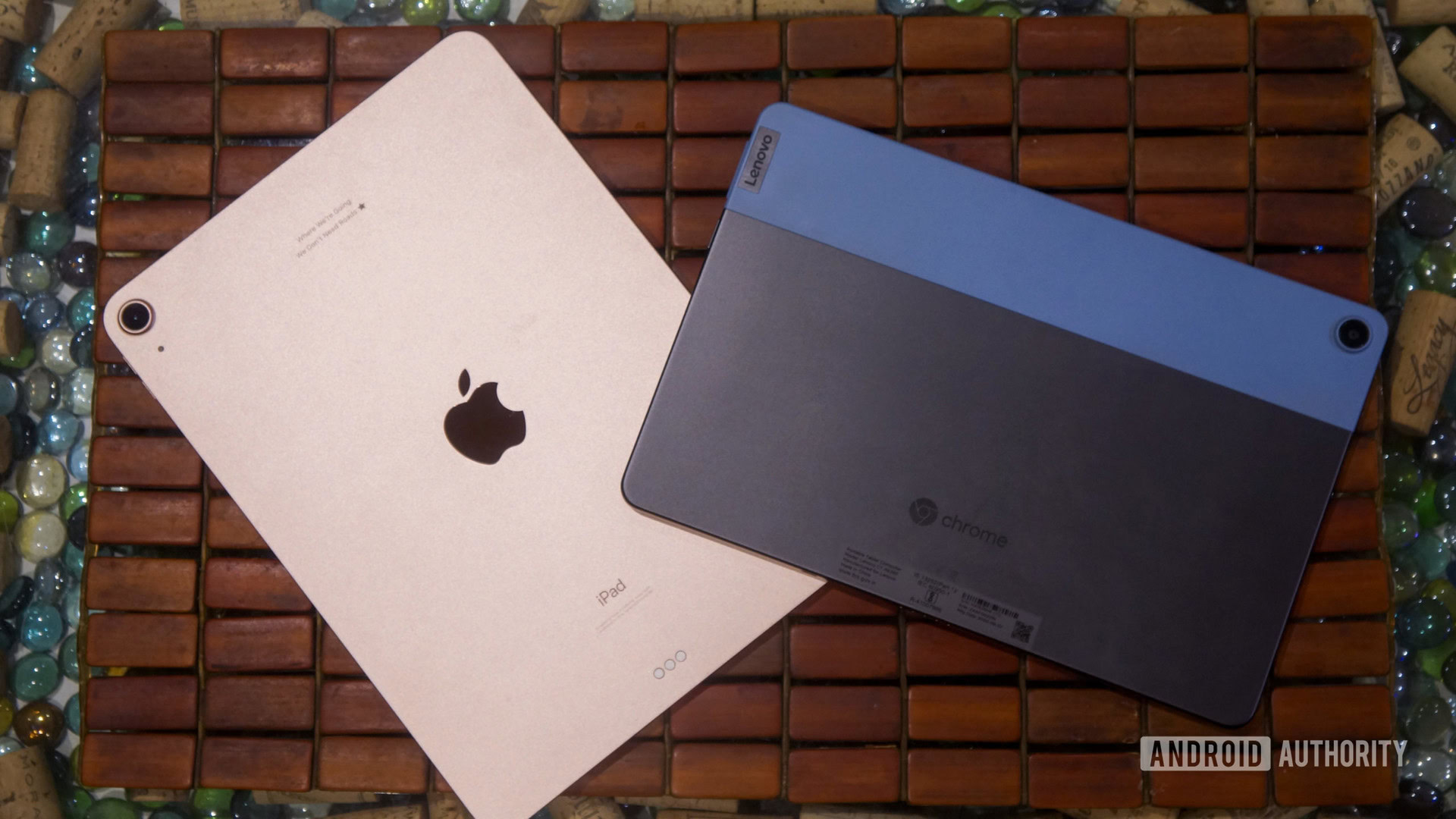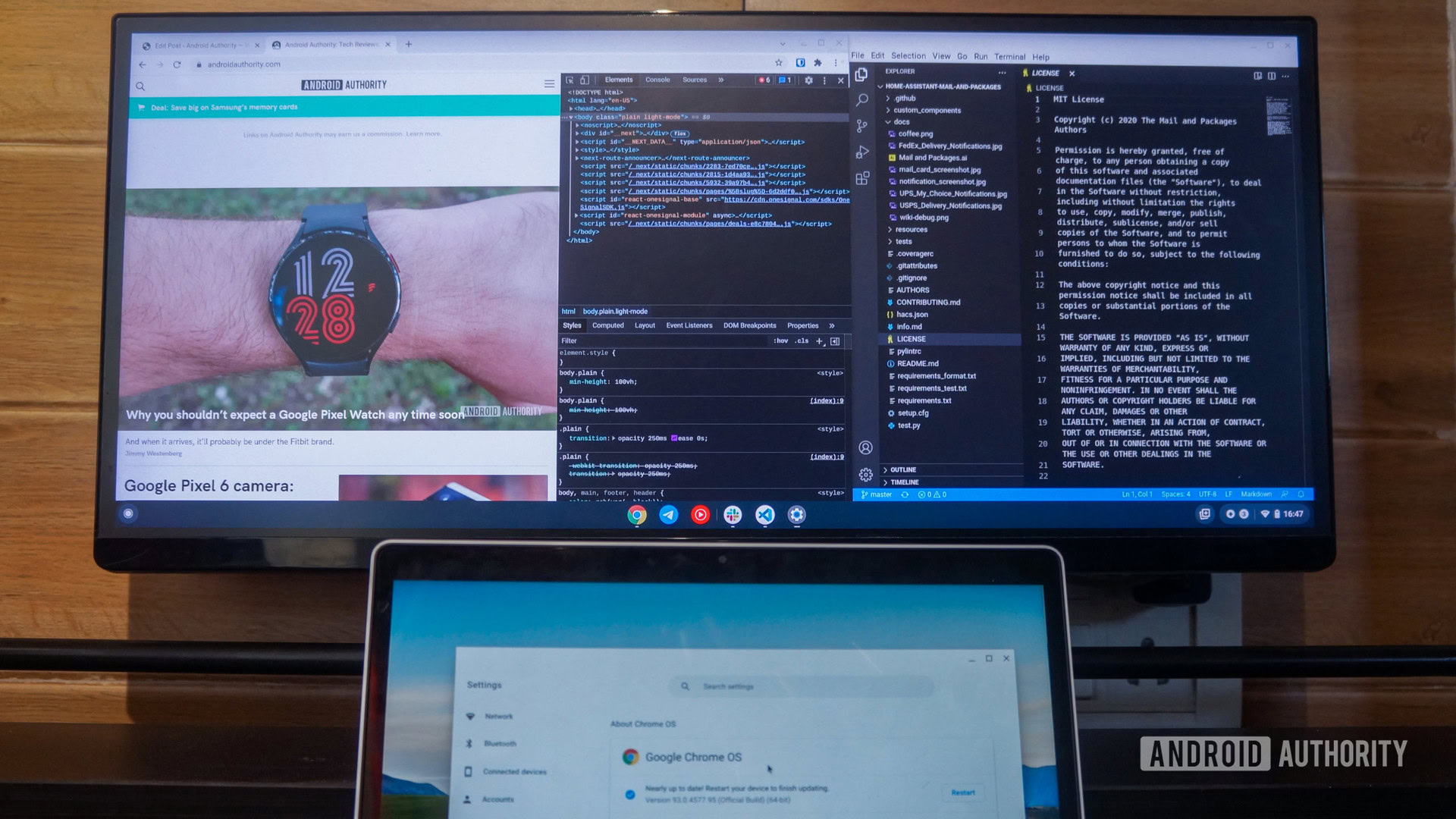Affiliate links on Android Authority may earn us a commission. Learn more.
Change my mind: Detachable Chromebooks are better mobile computers than any iPad

Some of you might read the title and scoff at the idea of Chromebooks competing with any modern-day iPad. I once thought along those lines too, before I got hands-on with the Lenovo Duet — a Chromebook with a detachable keyboard/trackpad accessory included in the box.
A week or so ago, I tried out iPadOS 15 on the 2020 iPad Air for the first time. After using the Duet as my primary writing machine, I expected to be blown away. The iPad has a lot going for it hardware-wise, including a still-unbeaten SoC. And, of course, this particular iPad costs nearly three times as much as the Duet once you factor in Apple’s Magic Keyboard.
Yet, only a few days later, I couldn’t help but feel a little letdown. Performing singular tasks like watching a video or browsing social media worked decently on the iPad. However, the experience didn’t hold up as well in my daily workflow involving a mix of research, writing, and heavy multitasking. While there’s no denying that iPadOS has come a long way, it’s unfortunately still far too limiting.
Read more: Chromebook vs iPad — Which is best for you?
On its own, this observation probably wouldn’t be very interesting. But considering how fervently Apple markets the iPad as the only computer you’ll ever need, it’s startling that a $250 detachable Chromebook one-ups it in so many areas.
Apple will be quick to point at the iPad’s class-leading performance, vast app library, and overall tight ecosystem integration. But I’d argue that these metrics alone don’t guarantee a great user experience. Most of us don’t edit photos or manipulate graphics for a living. And in most traditional productivity scenarios, multitasking and versatility are often more important than raw performance. Detachable Chrome OS devices nail the former, even with much inferior hardware. Let me explain.
Why I think Chrome OS is the winner for portable productivity

The difference between Chrome OS and iPadOS becomes immediately apparent when you connect a keyboard and trackpad. While iPadOS will only surface a lonesome mouse cursor, Chrome OS will switch to a full-blown desktop mode. The latter lets you resize individual apps and position them as you see fit. There’s even multiple desktop support — something that Apple actually pioneered with macOS X Leopard in 2006.
An iPad can run apps side-by-side and a third one can be swiped in temporarily. You can even use the keyboard for navigating around the UI, much to my surprise. But two layouts just don’t offer as much multitasking flexibility as floating windows or multiple tiles, like in some Linux-based window managers. Even the Galaxy Z Fold 3 lets you open three apps at a time when unfolded. Moving on, though, there’s no vertical split screen in iPadOS either, which Chrome OS will allow in tablet mode.
iPadOS' multitasking is limited and frustrating, even with the improvements in iOS 15.
Then there’s the subject of RAM management. In my time with the iPad Air, I found that it constantly refreshed background tasks if I walked away from the device. Even with presumably enough free memory, iPadOS opted to suspend apps and prioritize standby battery life instead.
In contrast, Chromebooks enter a low power mode at the operating system level — much like Windows or macOS. The downsides are that you can’t have media playing with the screen off like you can with an iPad — and waking up from this deeper sleep state is a hair slower. But at least it doesn’t disrupt your workflow by constantly flushing background tasks after a short while. Even after hours or days of sleep, Chrome OS will restore all formerly running apps — no reload necessary.
I could go on about how my Chromebook has proven less frustrating to use over the span of a single week, but in the interest of saving some time, here’s a quick summary:
- Multiple user profiles: Chrome OS has dedicated user profiles, similar to Android, Windows, macOS, and even Apple’s tvOS. But with the iPad, there’s no such separation. If you’re sharing one device between family members, you better remember to log out of your personal accounts in Safari and individual apps. The only alternative is for each individual to buy their own iPad — not ideal.
- External displays: Apple drew our attention to the iPad Pro’s Thunderbolt port, which has enough bandwidth to output at 6K resolution. However, you still cannot extend your iPad to an external monitor, only mirror whatever’s on the screen. Needless to say, Chrome OS has no such limitation and can properly extend the desktop to as many displays as the port can handle. Unfortunately, the Duet’s USB port can only handle 1080p 30Hz displays, but newer detachable Chromebooks have a lot more bandwidth.
- Niche use-cases: For all its horsepower, the iPad is still constrained in many professional workflows. Take web development, for instance. Chrome OS bundles the full Chrome browser, replete with DevTools. On top of that, you can install alternative browsers (yes, even Firefox) and development tools like Visual Studio Code through Linux. With an iPad, you’ll either need a macOS machine nearby for debugging or have to pony up for a third-party app.
- Price and value: My reference Chromebook, the Lenovo Duet, retails for a mere $250. Contrast that with even the cheapest iPad and you’re already paying nearly a hundred bucks extra. You will also need a keyboard if you want to get some serious work done, by which time you’re flirting with the $500 price point. For less than that, you could get the updated Lenovo Duet 5 with a 13.3-inch OLED screen. The HP X2 11 is another detachable Chromebook that just hit the market, although it is a bit pricey at $599. Still, it’s considerably cheaper than the iPad setup I tested.
There were some things about iPadOS that worked well in my time using it. I was impressed by Safari, which not only offered a desktop-like web browsing experience but also often loaded websites faster than the Chromebook. The OS also surfaced a plethora of keyboard shortcuts — enough to satisfy most power users. Additionally, all of the things the iPad is known for, it did very well. Playing games and watching media on an iPad is a much better experience than most Chromebooks, thanks to the great hardware on offer and the broad app ecosystem of the App Store.
Chrome OS lets you resize windows, connect external displays, and create separate user profiles. Why can't you do all of that on the iPad?
As for the future of iPadOS, this isn’t the first time Apple has tried the slow and iterative approach to improving its operating system. Back when the first iPhone landed, it was conspicuously missing the ability to copy and paste text. Incidentally, this was a feature BlackBerry users held dear.
Yet, as we know today, Apple managed to win market share with the iPhone despite such early glaring omissions. It even added a way to copy and paste a whole two years later with iOS 3.0. Similarly, I’m sure that iPadOS will become a viable laptop replacement someday. Until then, detachable Chromebooks will serve me well.
Which OS would you rather use on your portable, everyday computer?
Of course, that’s just my opinion. Now I want to hear yours! If you don’t agree with me, head to the comment section below, tell me why I’m wrong, and maybe you’ll be able to change my mind. I’ll do my best to reply to as many comments as possible so we can start a proper conversation. Also, share your opinion if you agree with my take — I’d love to see how many people are on my side.